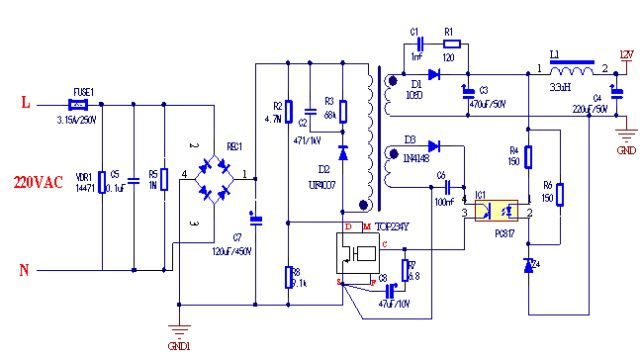What is optocoupler, what are its features, and which circuits are used?
First, the optocoupler adjusts the voltage in the switching power supply
We know that as a switching power supply, the optocoupler's power supply in the circuit is obtained from the secondary voltage of the high-frequency transformer. Once the output voltage is reduced for various reasons, the feedback current will increase accordingly. The corresponding increase becomes larger, and as a result, the output voltage rises; if the output voltage rises, the current will become smaller, the duty ratio will also decrease, and the output voltage will decrease.
Once the secondary load of the high-frequency transformer is overloaded or the switching circuit is faulty, there is no optocoupler power supply. At this time, the optocoupler controls the switching circuit to fail to start, and finally the protection switch is not broken down, so the optocoupler is in the switching power supply. Generally, it functions as isolation, providing feedback signals and switching.
The following figure shows a switching power supply circuit composed of an optocoupler PC817 and a Zener diode. Some switching power supplies together with the TL431 form a circuit with higher accuracy. Note that such optocouplers are typically linear optocouplers.

Second, the optocoupler acts as a switch in the load of AC
Since the optocoupler has unidirectional transmission and the input is electrically isolated from the output, the output signal has no influence on the input end, so it is widely used in various isolation circuits. For power electronics, it is applied in AC load. More, through the two-way thyristor together to form a strong anti-interference isolation circuit, as shown below, pay attention to increase the current limiting resistor, in addition to increase the RC absorption loop or parallel varistor in the output load, which helps protect the load .

Third, zero-crossing detection
There are many ways to achieve zero crossing. There are two diodes in series, which can also be converted by optocoupler, as shown below.
Two optocouplers are used, the AC input is used, and the two optocouplers are connected in parallel. In the positive and negative half cycle of the mains, the two optocouplers are turned on respectively. When the mains is not at the zero crossing, only one optocoupler is turned on. The output is low. When the mains goes to zero crossing, the two optocouplers are not conducting. At this time, due to the action of R3, the pin outputs a high level, so that a pulse signal with a period of 10ms is obtained at the output end. Since this circuit is isolated by optocouplers, this zero-crossing detection circuit is more secure than the circuit of the series diode.

Fourth, other applications
In addition to these three, there are other applications for optocouplers, such as trigger circuits, logic circuits, pulse amplifier circuits, and so on.
